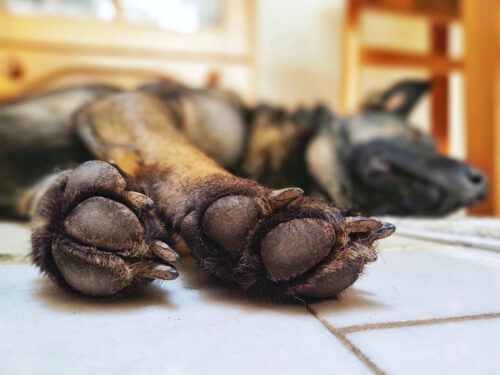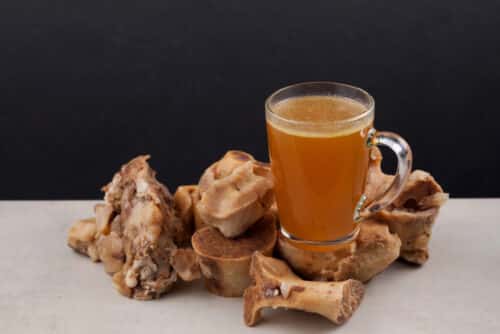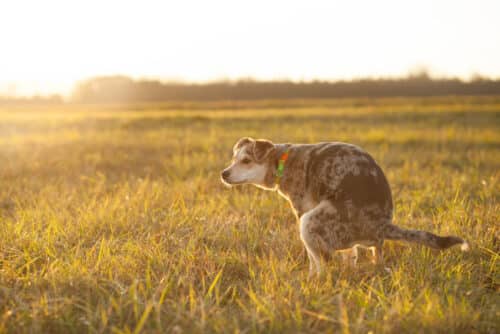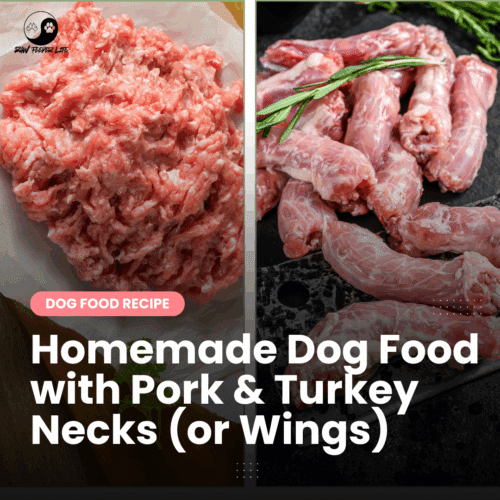Keep the Tail Wagging is supported by pet parents. I occasionally earn a commission (at no additional cost to you) when you click through an affiliate link to one of my favorite products. Thank you for your support. Read More
Bone broth is more than just a trendy topper; it’s a time-tested way to boost your dog’s nutrition, whether you feed kibble, raw, or home-cooked meals. It’s affordable, easy to make, and packed with nutrients that support joint health, digestion, and overall vitality.
In this post, we’ll explore:
- The benefits of bone broth for dogs
- Simple bone broth recipes (including optional veggies, herbs & mushrooms)
- Why you don’t need apple cider vinegar
- Histamine concerns & when to skip broth
- Why some bone broth recipes gel and some don’t
- Where to get bones without breaking the bank
Why Bone Broth Is Great for Dogs
Bone broth is made by slowly simmering bones in water over 12-48 hours. This long, gentle cooking process pulls nutrients like collagen, gelatin, amino acids, and minerals from the bones and connective tissue.
Key Benefits:
- Supports joint health – thanks to glucosamine, chondroitin, and collagen
- Promotes hydration – ideal for kibble-fed dogs
- Soothes sensitive tummies – gentle and easy to digest
- Entices picky eaters – dogs love the flavor!
- Helps with brain & gut health – rich in glycine and other amino acids
Easy Bone Broth Recipe for Dogs
Here’s a simple recipe to get you started. You can make bone broth in a slow cooker, Instant Pot, or on the stovetop.
Basic Bone Broth
Ingredients:
- 2–3 lbs raw or cooked bones (poultry, beef, lamb, duck, etc.)
- Enough water to cover the bones
- Optional: 1–2 tsp apple cider vinegar (see note below)
Instructions:
- Add bones to a pot and cover with water.
- Bring to a simmer and skim off any foam.
- Simmer gently:
- Poultry bones: 12–24 hours in a slow cooker, 2-3 hours in an Instant Pot
- Beef/lamb bones: 24–48 hours in a slow cooker, 3-4 hours in an Instant Pot
- Let cool, strain, and store in glass jars in the fridge (5 days) or freezer (3–6 months).
Use silicone molds to portion and freeze for easy serving! Or warm what you need on the stovetop to pour over cold food, taking the chill away.
Variations with Extra Nutrients
Once your dog tolerates basic broth, feel free to experiment with safe, nutritious add-ins:
Functional Bone Broth
- Add reishi, shiitake, or turkey tail mushrooms (dried or fresh)
- Great for immune support, detox, and reducing inflammation
Gut & Immune Boosting Broth
- Add herbs like parsley, oregano, dandelion root, or thyme
- Use 1-2 tsp dried or 1 tbsp fresh herbs per batch
Veggie Blend Broth
- Add chopped carrots, celery, zucchini, or kale in the last few hours
- Boosts fiber and vitamin content
Garlic? Yes — in moderation!
- A small amount of fresh garlic is safe and beneficial for most dogs
(1 clove per 20-30 lbs of body weight, added at the end of cooking)
Always introduce new ingredients slowly and watch for reactions.
Cooking Time for Various Bones
For Instant Pot bone broth, you can shorten the cooking time significantly compared to stovetop or slow cooker methods – but still get a rich, nutrient-dense broth.
Poultry Bones (chicken, turkey, duck, etc.)
- High Pressure: 2–3 hours
- Natural Release: 30–40 minutes
- This extracts plenty of collagen and nutrients without overcooking into a strong, bitter flavor.
Beef or Lamb Bones
- High Pressure: 3–4 hours
- Natural Release: 30–40 minutes
- Larger, denser bones need extra time for collagen breakdown and mineral extraction.
A Few Other Instant Pot Tips
- Always let the Instant Pot depressurize naturally to keep broth clear and avoid splattering.
- If you want a lighter flavor or lower histamine content, cut the pressure cooking time in half (1-1.5 hours for poultry, 2 hours for beef/lamb) and use the broth immediately or freeze right away.
- Include jointy bones (feet, necks, wings, knuckles) to help your broth gel.
Why You Don’t Need Apple Cider Vinegar
You may have heard that apple cider vinegar (ACV) helps “pull minerals from the bones.” While that’s technically true, studies show the difference is minimal – and often not worth it if your dog is sensitive to ACV or acidic foods.
Many dogs thrive on bone broth without any vinegar at all.
If you do use it, stick to 1-2 tsp per batch, and never exceed 1 tsp per 20 lbs of body weight per day in your dog’s food.
What About Histamines?
Bone broth is considered a high-histamine food, especially if:
- It simmers for long periods (24+ hours)
- It’s made from previously frozen bones
- It’s stored for several days in the fridge
This can be a problem for dogs with:
- Allergies or chronic itching
- Digestive upset
- Mast cell issues or skin sensitivities
Signs of a histamine reaction:
- Itching or red skin
- Gassiness or loose stool
- Lethargy after eating
If this sounds like your dog, consider:
- Making a meat stock instead (simmer meat and bones for 1–2 hours only)
- Freezing broth immediately to slow histamine formation
- Trying broth made with fresh (never frozen) bones
Why Doesn’t My Bone Broth Gel?
The gel consistency comes from collagen and gelatin released during cooking.
Your broth is more likely to gel if:
- You use jointy bones (feet, necks, wings, knuckles)
- You cook it long enough
- You don’t add too much water
But don’t worry – even if it doesn’t gel, it’s still nutritious!
Where to Get Affordable Bones
Bone broth doesn’t have to be expensive. Try:
- Local butchers (ask for “dog bones” or soup bones)
- Raw feeding co-ops or buying clubs
- Ethnic grocery stores (especially for feet, necks, etc.)
- Farmers and hunters (many will give away scraps)
- Online raw food suppliers
Tip: Freeze bones from your own meals and save up enough to make a batch.
Feeding Bone Broth to My Dogs
Bone broth is one of the easiest, most budget-friendly ways to upgrade your dog’s bowl – no matter what you feed. It’s hydrating, healing, and customizable. I spend a weekend making bone broth every other month. I usually make 20+ jars at a time, which I freeze until ready to use.
I use warmed bone broth to take the chill off my dogs’ meals because I prefer not to feed cold foods. Feeding cold food to dogs (like straight from the fridge or freezer) can be hard on their digestive system. Cold food slows digestion, can cause stomach upset in sensitive dogs, and may even constrict blood vessels in the gut, making nutrient absorption less efficient. Serving food at room temperature (or lightly warmed) is gentler on the stomach and closer to the natural body temperature of prey animals dogs would eat in the wild.
This is a personal choice after speaking with several holistic veterinarians.
Just remember:
- Use bones from quality sources (pasture-raised or organic when possible)
- ACV is optional – skip it if your dog’s sensitive
- Watch for histamine issues in allergic dogs
- Keep it simple, and don’t overthink it!





